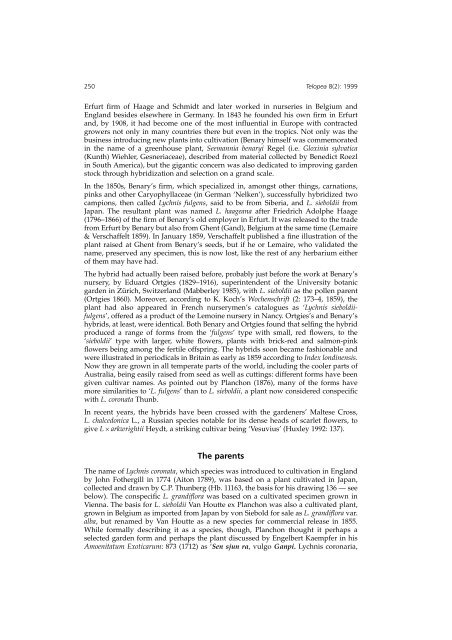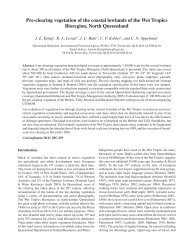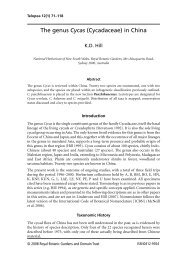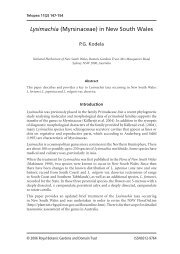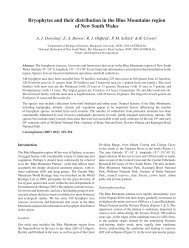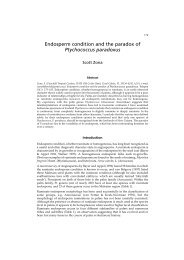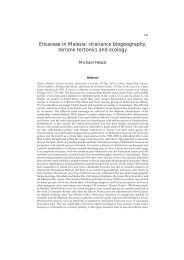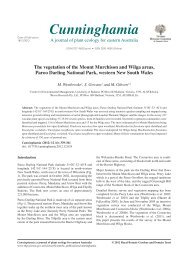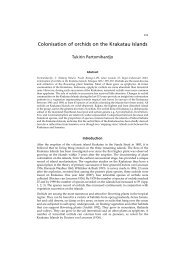Silene banksia - Royal Botanic Gardens
Silene banksia - Royal Botanic Gardens
Silene banksia - Royal Botanic Gardens
Create successful ePaper yourself
Turn your PDF publications into a flip-book with our unique Google optimized e-Paper software.
250 Telopea 8(2): 1999<br />
Erfurt firm of Haage and Schmidt and later worked in nurseries in Belgium and<br />
England besides elsewhere in Germany. In 1843 he founded his own firm in Erfurt<br />
and, by 1908, it had become one of the most influential in Europe with contracted<br />
growers not only in many countries there but even in the tropics. Not only was the<br />
business introducing new plants into cultivation (Benary himself was commemorated<br />
in the name of a greenhouse plant, Seemannia benaryi Regel (i.e. Gloxinia sylvatica<br />
(Kunth) Wiehler, Gesneriaceae), described from material collected by Benedict Roezl<br />
in South America), but the gigantic concern was also dedicated to improving garden<br />
stock through hybridization and selection on a grand scale.<br />
In the 1850s, Benary’s firm, which specialized in, amongst other things, carnations,<br />
pinks and other Caryophyllaceae (in German ‘Nelken’), successfully hybridized two<br />
campions, then called Lychnis fulgens, said to be from Siberia, and L. sieboldii from<br />
Japan. The resultant plant was named L. haageana after Friedrich Adolphe Haage<br />
(1796–1866) of the firm of Benary’s old employer in Erfurt. It was released to the trade<br />
from Erfurt by Benary but also from Ghent (Gand), Belgium at the same time (Lemaire<br />
& Verschaffelt 1859). In January 1859, Verschaffelt published a fine illustration of the<br />
plant raised at Ghent from Benary’s seeds, but if he or Lemaire, who validated the<br />
name, preserved any specimen, this is now lost, like the rest of any herbarium either<br />
of them may have had.<br />
The hybrid had actually been raised before, probably just before the work at Benary’s<br />
nursery, by Eduard Ortgies (1829–1916), superintendent of the University botanic<br />
garden in Zürich, Switzerland (Mabberley 1985), with L. sieboldii as the pollen parent<br />
(Ortgies 1860). Moreover, according to K. Koch’s Wochenschrift (2: 173–4, 1859), the<br />
plant had also appeared in French nurserymen’s catalogues as ‘Lychnis sieboldiifulgens’,<br />
offered as a product of the Lemoine nursery in Nancy. Ortgies’s and Benary’s<br />
hybrids, at least, were identical. Both Benary and Ortgies found that selfing the hybrid<br />
produced a range of forms from the ‘fulgens’ type with small, red flowers, to the<br />
‘sieboldii’ type with larger, white flowers, plants with brick-red and salmon-pink<br />
flowers being among the fertile offspring. The hybrids soon became fashionable and<br />
were illustrated in periodicals in Britain as early as 1859 according to Index londinensis.<br />
Now they are grown in all temperate parts of the world, including the cooler parts of<br />
Australia, being easily raised from seed as well as cuttings: different forms have been<br />
given cultivar names. As pointed out by Planchon (1876), many of the forms have<br />
more similarities to ‘L. fulgens’ than to L. sieboldii, a plant now considered conspecific<br />
with L. coronata Thunb.<br />
In recent years, the hybrids have been crossed with the gardeners’ Maltese Cross,<br />
L. chalcedonica L., a Russian species notable for its dense heads of scarlet flowers, to<br />
give L × arkwrightii Heydt, a striking cultivar being ‘Vesuvius’ (Huxley 1992: 137).<br />
The parents<br />
The name of Lychnis coronata, which species was introduced to cultivation in England<br />
by John Fothergill in 1774 (Aiton 1789), was based on a plant cultivated in Japan,<br />
collected and drawn by C.P. Thunberg (Hb. 11163, the basis for his drawing 136 — see<br />
below). The conspecific L. grandiflora was based on a cultivated specimen grown in<br />
Vienna. The basis for L. sieboldii Van Houtte ex Planchon was also a cultivated plant,<br />
grown in Belgium as imported from Japan by von Siebold for sale as L. grandiflora var.<br />
alba, but renamed by Van Houtte as a new species for commercial release in 1855.<br />
While formally describing it as a species, though, Planchon thought it perhaps a<br />
selected garden form and perhaps the plant discussed by Engelbert Kaempfer in his<br />
Amoenitatum Exoticarum: 873 (1712) as ‘Sen sjun ra, vulgo Ganpi. Lychnis coronaria,


